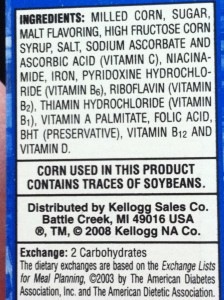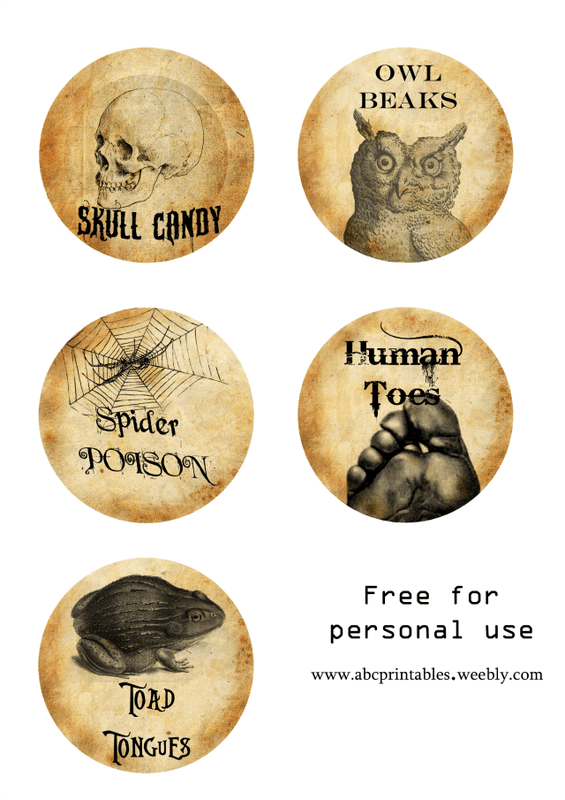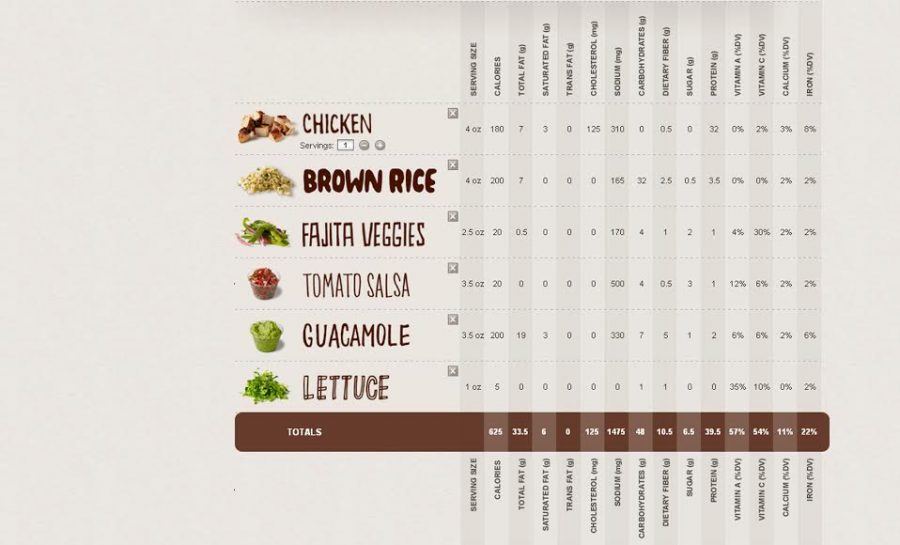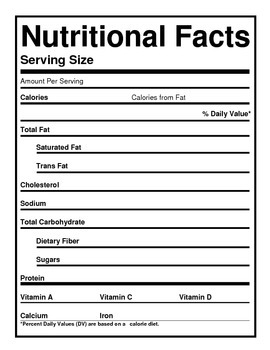45 fun facts about food labels
Get the Facts: Know Your Food Label | Health Powered Kids Locate the Nutrition Facts label for your food item (s). Find the Serving Size and Servings Per Container. Remember: all of the nutrition information on the label is based on one serving of the food. A package of food often has more than one serving! Find the calories. They are the "fuel" our bodies need for our daily activities. 10 Food Label Facts - It Takes Time These facts are based on the Food Label Quiz found here. 1. If you're looking to avoid GMOs (Genetically Modified Organisms), don't trust the word "natural" on the label. The Consumer Reports Food Safety and Sustainability Center tested more than 80 processed foods containing corn or soy looking for genetically engineered (GE) DNA.
Food Labels | CDC If you eat the whole thing, you are eating 8 times the amount of calories, carbs, fat, etc., shown on the label. Total Carbohydrate shows you types of carbs in the food, including sugar and fiber. Choose foods with more fiber, vitamins, and minerals. Choose foods with lower calories, saturated fat, sodium, and added sugars. Avoid trans fat.

Fun facts about food labels
14 Bizarre Ingredients Hidden in Your Food Labels - The ... Food labels contain so many different information - from calorie count, nutritional information to ingredients. So what is the secret? Well, some of the ingredients that we consume daily in our favorite food come from the strangest places. For example, bread contains an ingredient that is derived from human hair. Yuck! medalerthelp.org › blog › organic-food-statistics24 Organic Food Statistics & Facts for a Much Healthier 2022 Apr 29, 2021 · 17. 62% of US consumers would purchase organic if it were more affordable, based on facts about healthy food. (Mintel) The authenticity of organic product labels is another concern, with a mere 26% of American consumers claiming they trust most organic food labels. Overall, as little as 13% think organic products are properly regulated. 18. › recycling-factsRECYCLING FACTS | recycleacrossamerica Food and paper waste used for food can be composted into nutrient rich soil and sold to farmers. Almost half of the food in the U.S. goes to waste - approximately 3,000 pounds per second. Food scraps make up almost 12% of municipal solid waste generated in the U.S. Many schools and businesses are starting to compost food waste on site.
Fun facts about food labels. 10 Surprisingly Unfamiliar Nutrition Facts Label Facts ... All of that aside here are 10 little known facts about the nutrition facts label: Foods with less than five calories meet the definition of "calorie free" If fat is present at a level below 0.5 g, the level of fat is expressed as 0 g 8 Surprising Facts About Nutrition Labels - Back to the ... Food labels break down total fat into saturated fats and trans fats (stay away from these), and total carbohydrates are broken down into dietary fibers (the good stuff) and sugars (the not so good stuff). 4. %DV Facts on Food Labeling And What You Should Know ... Food labeling is a requirement for most prepared foods, like: Cereals Breads Frozen foods Canned foods Desserts Snacks Beverages Nutritional labels for raw product s (vegetables and fruits) as well as for fish is voluntary. These types of products are referred to as "conventional" foods. The Science Behind Calories and Nutrition Facts Labels ... The calorie number we see on food labels refers to a kilocalorie (kcal), which is also known as a large calorie or a food calorie. A kilocalorie is 1 000 calories. A kilocalorie is 1 000 calories. One kilocalorie is the amount of energy it takes to heat one kilogram of water one degree Celsius at sea level.
Food Label Information and Facts- Tutorial Section: Here's an easy way to look at % DV on the Nutrition Facts label and make smart food choices every day: 5% or less is low - try to stay low in total fat, saturated fat, cholesterol and sodium. 20% or more is high - try to stay high in vitamins, minerals and fiber Total Fat The total fat is the number of fat grams in one serving. The Evolution of Food Labels: A Timeline | 48HourPrint The iconic nutrition facts label was only introduced in the year 1990, but it was a culmination of more than a century of mandated food labeling and branding. Learn the key historical developments and interesting facts that shaped the function of food labels that we know today. Food Regulation Facts - What your label doesn't tell you ... It provides access to statistics and facts sourced from FDA, CDC, AAFCO, PFI and other sites. Often times these statistics and facts contradict information published by these same organizations. FRFA provides AAFCO meeting agenda's to members prior to the meetings, allowing members the opportunity to contribute to the agenda at the meetings. The Importance of Reading the Food Label and Nutritional Facts The Importance of Reading Food Labels This information does two things: The Basics of Reading a Nutrition Label 1. Serving Size 2. Calories per Serving 3. Percent Daily Values 4. Nutrient Contents 5. Vitamins & Minerals 6. Ingredient List Putting it All Together Reading food labels makes a big difference when it comes to your family's health.
Understanding Food Labels - Nutrition: Science and ... The FDA uses the following definitions for interpreting the %DV on food labels:4 5%DV or less means the food is low in a nutrient. 10% to 19%DV means the food is a "good source" of a nutrient. 20%DV or greater means the food is high in a nutrient. Get the Facts on Dietary Guidelines MyPlate and Food Labels New food labels highlight important information, such as the amount of vitamin D, potassium and added sugars. Nutrient reference values, expressed as % Daily Values, which help you see how a specific food fits into your overall daily diet. Nutrition Facts Pocket Label Guide | Food Hero Food Hero's Nutrition Facts Label Pocket Guide provides information in Spanish as well as relevant imperial to metric conversions to help consumers with interpreting the Nutrition Facts information. The guide is designed to fit into a pocket, small purse, or bag to be accessible while grocery shopping. Nutrition Facts Pocket Label Guide. › food › nutrition-education-resourcesThe New Nutrition Facts Label | FDA Apr 13, 2022 · En Español (Spanish) The U.S. Food and Drug Administration (FDA) has updated the Nutrition Facts label on packaged foods and drinks. FDA is requiring changes to the Nutrition Facts label based on ...
Figuring Out Food Labels (for Kids) - Nemours KidsHealth In addition to total carbohydrate, the food label lists dietary fiber, total sugar, and added sugars per serving. Some foods naturally contain sugar, like fruit and milk. Snack foods, candy, and soda, though, often have added sugars. Added sugars add calories without important nutrients. Protein
How to Understand and Use the Nutrition Facts Label | FDA Dietary fiber, vitamin D, calcium, iron ad potassium are nutrients on the label that Americans generally do not get the recommended amount of. They are identified as nutrients to get more of....
Nutrition Facts and Food Labels - Eatright.org Get to know the basics of the Nutrition Facts label, and understand the parts and pieces, from serving size, total calories and fat to percent of Daily Values. Teach Your Teen about Food Panels If decoding the information on a food package is a challenge for adults, think of how hard it is for teens who are just beginning to make choices for ...
› custom-printing › labelsShop Custom Labels & Stickers by Use | Avery.com Custom Labels & Stickers by Avery WePrint. Create beautiful personalized address labels, shipping labels, bumper stickers, candle labels, CD labels, honey labels, wine bottle labels, beer labels, wedding labels and more with custom printing from Avery WePrint.
Food Labels | Nutrition.gov Food Labels Food labels can help you make healthy choices when buying food in grocery stores or restaurants. Labeling Organic Products USDA, Agricultural Marketing Service, National Organic Program Learn about organic foods, requirements, and how they are labeled. Calories on the Menu HHS, Food and Drug Administration
From the Label to the Table! - Kids Environment Kids ... Products labeled "light" or "lite" must have 1/3 fewer calories or 1/2 the fat of the foods to which they are compared. "Light" also can mean that salt has been reduced by 1/2. Look for foods with lower levels of saturated fats. The sodium level tells you how much salt is in food. Look for products that have more fiber and less sugar.
100 Fun Food Facts You Wont Believe Are True - The Fact Site A common red food dye, carminic acid, is made from the crushed bodies of a beetle called the Dactylopius coccus. This acid is used in maraschino cherries, strawberry and raspberry flavored candy, and lipstick. Crackers are worse for your teeth than sugar. Acid is the biggest cause of tooth decay, not sugar!
3 Things to Know About Your Food's Nutrition Label | Live ... One manufacturer may count six ounces as a serving, while the other only counts four. 2. "Percent Daily Value" is based on a 2,000-calorie daily diet. This means that the percentages serve as a...
10 Facts About Food Regulation The Government Hopes You ... Shocking Food Facts See Gallery. Clarification: Slide 8 of the above slideshow has been edited to reflect that foods can bear a "zero trans fats" label, as opposed to "no trans fats." Suggest a correction. More: chipotle Food For Thought fda Food Taste . MORE IN Food & Drink.
Quiz: How Much Do You Know About Food Labels? If you're trying to cook and eat low-sodium, be on the lookout for these words on the label. They all contribute to the sodium count in your diet. 4 If a food has an "organic" label of any type, all of its ingredients are organic. Correct Answer for Question 4: False. In this case, the specific label matters.
Food Labels 101: Understanding the Nutrition Facts Label ... Nutrition labels are based on a daily 2,000 calorie diet. Depending on your age, gender and activity level, you may need to consume more or less than 2,000 calories per day, so keep this in mind when viewing each label. Now let's take a look at the parts of the nutrition facts label and break it all down. Anatomy of a Nutrition Facts Label
› mind-blowing-food-facts100 Mind-Blowing Facts About Food — Eat This Not That It will appear on your food label under the guise of "confectioner's glaze." 13 Nutmeg can cause hallucinations Shutterstock Too much of a spice can be a bad thing, and nutmeg is no exception. If you have two or more teaspoons of the spice, it can actually cause hallucinations! 14 Cucumbers are mostly water Shutterstock
hobbylark.com › party-games › Positively-FacebookYear 2004 Fun Facts, Trivia, and History - HobbyLark Feb 28, 2019 · This article teaches you fun facts, trivia, and history events from the year 2004. Find out about popular TV shows, movies, music, books, cars, interesting foods, sports facts, and other pop culture trends to get the right mix of questions and answers for your 2000s-themed trivia quiz.
› a37170576 › fun-facts103 Random Fun Facts - Interesting Trivia That Will Surprise You Aug 03, 2021 · Prepare for trivia night with these 103 fun facts that are sure to surprise you and everyone you tell them to. Or just peruse the list if you're in the mood to learn new things.
An In-Depth Look at the History of Food Product Labels 1938: Food, Drug, and Cosmetic Act. As manufacturing became more complex and food production found new additives to include in its recipes, the FDA created new food labeling guidelines. In 1938, the FDA stated that all food and cosmetic products now needed labels for any products containing artificial flavorings, flavor additives, or chemicals.

UNDERSTANDING FOOD LABELS - MAKE THE BEST FOOD DECISIONS | BEAUTY | Reading food labels, Food ...
› recycling-factsRECYCLING FACTS | recycleacrossamerica Food and paper waste used for food can be composted into nutrient rich soil and sold to farmers. Almost half of the food in the U.S. goes to waste - approximately 3,000 pounds per second. Food scraps make up almost 12% of municipal solid waste generated in the U.S. Many schools and businesses are starting to compost food waste on site.
medalerthelp.org › blog › organic-food-statistics24 Organic Food Statistics & Facts for a Much Healthier 2022 Apr 29, 2021 · 17. 62% of US consumers would purchase organic if it were more affordable, based on facts about healthy food. (Mintel) The authenticity of organic product labels is another concern, with a mere 26% of American consumers claiming they trust most organic food labels. Overall, as little as 13% think organic products are properly regulated. 18.

Food labels are an important source of information about the food and thus printing of food ...
14 Bizarre Ingredients Hidden in Your Food Labels - The ... Food labels contain so many different information - from calorie count, nutritional information to ingredients. So what is the secret? Well, some of the ingredients that we consume daily in our favorite food come from the strangest places. For example, bread contains an ingredient that is derived from human hair. Yuck!












Post a Comment for "45 fun facts about food labels"